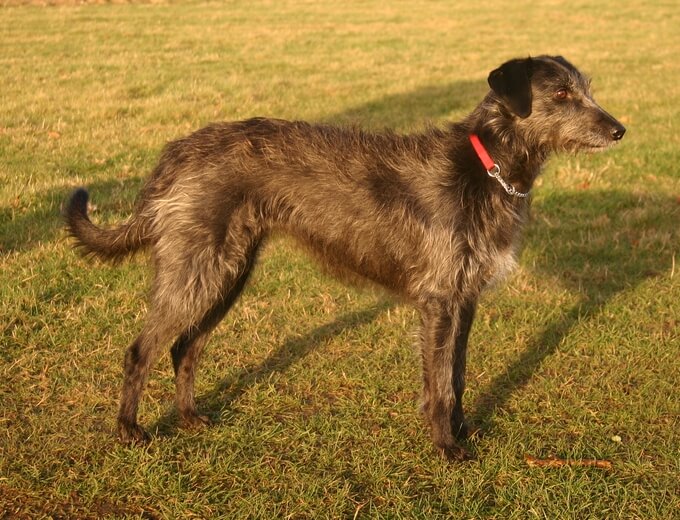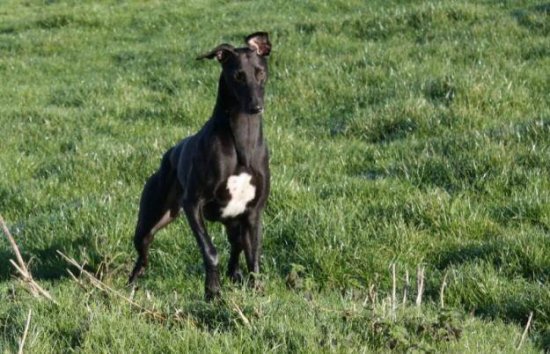All About the Lurcher Dog

Although it isn’t a recognized breed, the Lurcher is an established and appreciated mixed breed. Generally, it has different characteristics depending on the two breeds that have been mixed, so it isn’t possible to speak of a uniform appearance for this dog.
However, it is one of the most unknown crosses, so, in this article, you’ll find everything you need to know about the lurcher dog. If you’re thinking of adopting one of these wonderful animals, don’t look for flaws here, because they are all good words for them. Let’s start.
Characteristics and appearance
The lurcher belongs to the category of large dogs, as its height varies between 69 and 76 centimeters (2.2 to 2.5 feet) and its weight can reach more than 30 kilograms (66 pounds). This variation will depend to a great extent on the breeds used in its crossbreeding.
This dog is obtained by crossing a sighthound breed (among which are the greyhound and the Borzoi) and working dogs such as the Border Collie, so its appearance is usually slender, but with strong muscles and a prominent ribcage. The coat is usually shaggy and unkempt, but there’s also a short-haired variety.
The head is slender, with a narrow muzzle and the ears tend to be rounded, pointed and small. The tail is usually long, thin, and curved. The coat colors vary greatly, as they’re usually a direct mix of their parents.

Origin of the lurcher
The mix known as the lurcher dog originated in the United Kingdom. It was the dog that traveled with the British gypsies, as they were looking for an animal with the strength of a working dog, but faster.
The prefix lur means “thief” in Romani, as the British gypsies were forced to steal to survive and to hunt on the roads they traveled.
This dog is the one that accompanies travelers on their way, used for hunting small game and to endure long walks. They’re fast, hardy, and loyal. It’s also known as the poacher’s dog, the dog of the fugitive, a derogatory denomination with respect to the criminal behavior of these people.
At present, although it still isn’t recognized as a breed and isn’t admitted in beauty contests because of its disheveled appearance, the lurcher is admitted as a mongrel among the general population. The crosses are usually varied depending on the parents.
Temperament
At the time, the breeding and training of these dogs responded to the needs of the gypsies, which varied depending on what type of life they had. Therefore, their education was intuitive and in accordance with the demands of the situation.
Also, thanks to this, these dogs are considered easy to train, as they learn quickly and cooperate easily. They also have a strong hunting instinct, as they have been crossed for a long time for this purpose.
So, if you’re thinking of living with a lurcher, you should take this into account when training it. On the other hand, they’re also very affectionate, loyal, and sensitive animals, as well as highly intelligent.
Lurcher health
Since it’s a mixed breed, it doesn’t usually have any specific health problems derived from its own genetics. However, it could inherit some of the congenital problems of its progenitors, such as the progressive atrophy of the retina of the Border Collie or the greyhound’s tendency to get fractures.
Apart from that, they’re robust dogs and, keeping them in good shape, they’ll enjoy a solid and easy to maintain health.
Tips to take care of this breed

Even with the good health that lurcher dogs usually have, you still shouldn’t neglect basic health measures. Here are some tips to help you improve their health:
- Give them a good diet and watch their weight.
- Provide good amounts of environmental enrichment: This is a very active and intelligent breed, so it’ll need large amounts of exercise and it will have to learn to keep itself amused.
- Pay attention to their training: They’re sociable dogs, but also sensitive. It’s very important to integrate them into the world in a positive way and through consistent training, so that socialization and behavioral problems don’t appear, nor anxiety, phobias or aggression.
- Don’t forget to visit the veterinarian: Even if they’re in good health, never miss regular check-ups at your trusted clinic or neglect their deworming and vaccination schedule.
And, of course, don’t forget that this is a breed that was created for exploitation, so their hunting instinct will be something to monitor on your long walks. So, if you have the opportunity to share your life with a lurcher, don’t hesitate for a second, because these wonderful dogs deserve all the love in the world.
All cited sources were thoroughly reviewed by our team to ensure their quality, reliability, currency, and validity. The bibliography of this article was considered reliable and of academic or scientific accuracy.
- Asins, E. G., & Pérez, F. M. G. Función diastólica en perros de razas lebreles.
- Chapagain, D., Virányi, Z., Wallis, L. J., Huber, L., Serra, J., & Range, F. (2017). Aging of attentiveness in border collies and other pet dog breeds: the protective benefits of lifelong training. Frontiers in aging neuroscience, 9, 100.
- Vilboux, T., Chaudieu, G., Jeannin, P., Delattre, D., Hedan, B., Bourgain, C., … & André, C. (2008). Progressive retinal atrophy in the Border Collie: a new XLPRA. BMC veterinary research, 4(1), 1-13.
This text is provided for informational purposes only and does not replace consultation with a professional. If in doubt, consult your specialist.